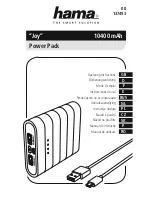
GB
- 20 -
The speci
fi
ed vibration value can be used to
compare the equipment with other electric power
tools.
The speci
fi
ed vibration value can be used for initi-
al assessment of a harmful e
ff
ect.
Keep the noise emissions and vibrations to a
minimum.
•
Only use appliances which are in perfect con-
ditions.
•
Service and clean the appliance regularly.
•
Adapt your working style to suit the appliance.
•
Do not overload the appliance.
•
Have the appliance serviced whenever ne-
cessary.
•
Switch the appliance off when it is not in use.
•
Wear protective gloves.
Residual risks
Even if you use this electric power tool in
accordance with instructions, certain resi-
dual risks cannot be rules out. The following
hazards may arise in connection with the
equipment’s construction and layout:
1. Lung damage if no suitable protective dust
mask is used.
2. Damage to hearing if no suitable ear protec-
tion is used.
3. Health damage caused by hand-arm vib-
rations if the equipment is used over a pro-
longed period or is not properly guided and
maintained.
5. Before starting the equipment
Before you connect the equipment to the mains
supply make sure that the data on the rating plate
are identical to the mains data.
Warning!
Always pull the power plug before making
adjustments to the equipment.
5.1 Fitting the dust extractor adapter (Fig. 2)
The adapter for the dust extraction system (5) and
the dust bag (6) must be
fi
tted (Fig. 2).
5.2 Setting the cutting depth (Fig. 3)
•
Set the required cutting depth with the setting
wheel (3).
•
The designations on the setting wheel reflect
the various sizes of biscuit dowels
•
Push the drive motor (11) forwards to check
the cutting depth. The plug must be discon-
nected from the mains supply for this purpo-
se.
•
You can adjust the cutting depth setting using
the screw (a).
Warning!
Before use, check that the guard hood reset sys-
tem works properly!
5.3 Setting the cutting angle and cutting
height (Fig. 4)
•
Undo the two screws for the angle adjustment
(2) and height adjustment (12).
•
Important! The set angle is indicated by the
arrow (b).
•
You can infinitely adjust the angle stop (10) to
the required angle between 0° and 90°.
•
Set the required height on the height scale
(a); the height of the groove should always be
in the center of the workpiece.
•
Now retighten the two screws.
•
A single pass will suffice for thin workpieces.
•
Several passes over the workpiece are requi-
red for thicker workpieces.
5.4 Changing the cutter (Figs. 5-6)
Danger! The plug must be disconnected from
the mains supply.
•
Remove the cover (a).
•
Place the face spanner (7) on the flange (b).
•
Press the locking knob; hold this knob and
turn the face spanner in the direction in which
the machine turns. After approximately half
a turn the locking knob will engage and the
flange can be released.
•
Release the cutter (c) from the flange (d).
•
Then pull the cutter (c) out of the base plate
(9).
•
Now fit the new cutter following the above in-
structions in reverse. Check that the direction
of
rotation of the cutter is correct.
•
Refasten the cover (a).
Danger!
Never press the locking knob (8) when the motor
is running. Ensure that the cutter is perfectly secu-
re before you start work.
Note!
Do not use blunt or damaged saw disk cutters.
Anl_SA_TC_BJ_900_SPK8.indb 20
Anl_SA_TC_BJ_900_SPK8.indb 20
14.02.2018 08:58:49
14.02.2018 08:58:49













































